Physical Address
304 North Cardinal St.
Dorchester Center, MA 02124
Injuries to the distal biceps tendon were at one time thought to be rare. Presently, however, these injuries are relatively common. This increase in the identification of distal biceps tendon injuries is multifactorial and likely due to improved patient and physician awareness, increased understanding of the injury, better reporting, improved physical examination maneuvers, and superior imaging techniques. As such, surgeons should be familiar with the presentation, physical examination, and treatment options available to manage acute injuries to the distal biceps tendon.
Acute injury to the biceps mechanism can theoretically occur at any point along its course from origin to insertion. This is especially true of penetrating injuries, with resultant disruption of the flexor mechanism. Typically, however, nonpenetrating injuries to the distal biceps tendon occur most frequently at the insertion. The most common injury type is complete rupture of the distal biceps tendon from the bicipital tuberosity. A partial rupture of the distal biceps tendon can also occur but is less frequent.
Partial ruptures of the distal biceps tendon can be focal, with detachment of part of the tendon at the insertion without retraction. Partial ruptures are reported to occur more commonly at the distal insertion point of the biceps tendon on the bicipital tuberosity in the part of the tendon that corresponds to the short head of the biceps. Occasionally, partial avulsions of the short head of the tendon can also proximally retract by longitudinal splitting of the biceps tendon, with resultant proximal retraction of the short head of the biceps muscle belly. In such cases, the short head of the distal tendon may be proximally retracted in the arm, while the long head portion of the distal biceps tendon is still attached to its footprint on the bicipital tuberosity.
In addition to insertional ruptures of the distal biceps tendon, injuries can also occur at the musculotendinous junction. Ruptures at the musculotendinous junction are rare. A common mechanism has been reported, with musculotendinous ruptures occurring with biceps loading with glenohumeral elevation, elbow extension, and forearm supination.
The incidence of distal biceps tendon ruptures has been variably reported in the literature. An earlier study reported an incidence of 1.2 : 100,000 persons per year ; more recently, the incidence has been reported to be a minimum of 5 : 100,000 persons per year. Additionally, the cohort of patients that sustains distal biceps tendon ruptures is typically male and middle-aged, with a higher prevalence of smoking and an increased body mass index (BMI). The effect of hand dominance has been contested—some studies have reported higher rates of injury on the dominant extremity, whereas another study has reported no significant effect of dominance.
The mean age of patients sustaining a distal biceps tendon rupture is 47 years, with approximately two-thirds of patients being between the ages of 35 and 54 years.
Generally, distal biceps tendon injuries tend to occur in men (>95%). Distal biceps tendon injuries do occur in women but at a lower incidence, older age (mean >60 years), and higher predominance of partial tears.
The biceps complex originates at the shoulder and inserts on the bicipital tuberosity of the radius. The long head of the biceps originates from the superior glenoid tubercle, whereas the short head originates from the coracoid process. The biceps mechanism rotates 90 degrees externally from origin to insertion ( Fig. 63.1 ) such that the short head part of the distal biceps tendon inserts distally and ulnarly on the bicipital tuberosity and the long head portion inserts proximally and ulnarly ( Fig. 63.2 ). The lacertus fibrosus functions as a landmark to assist with orientation because it has been reported to originate from the short head portion of the distal biceps tendon. Additionally, if the lacertus fibrosus remains intact with a complete distal tendon rupture, it prevents excessive proximal retraction of the biceps muscle.
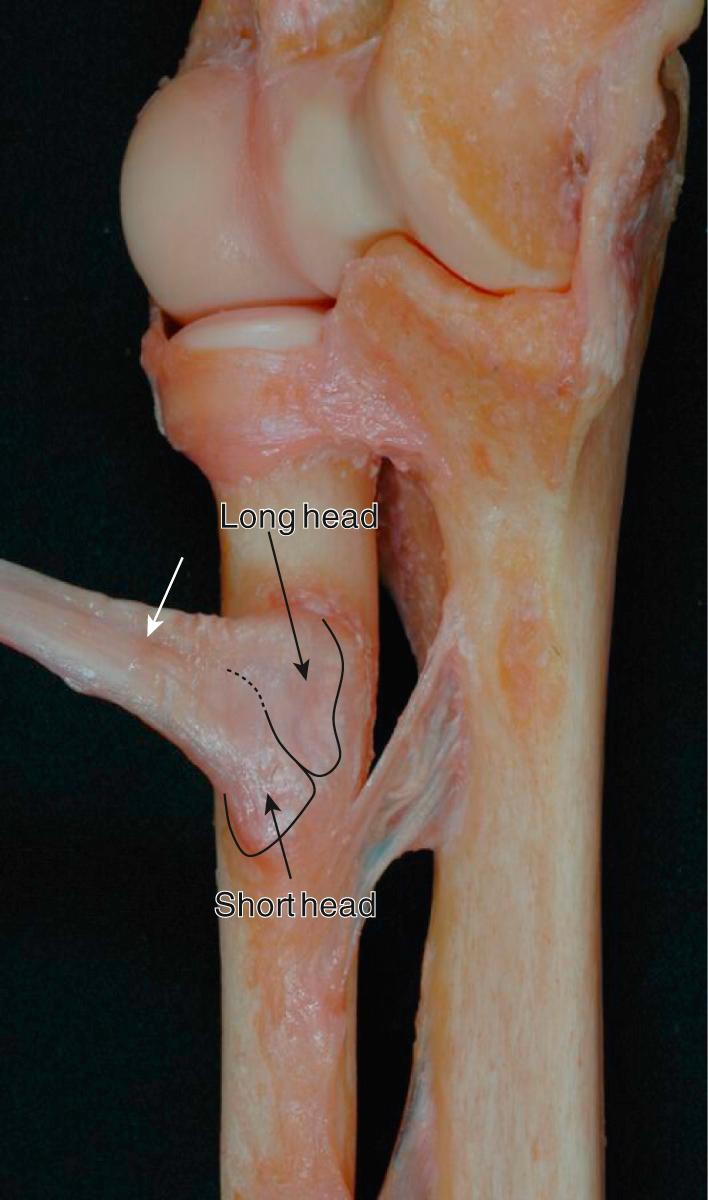
The distal biceps tendon has been described as ribbon shaped, with a mean extramuscular length of 63 ± 9 mm, width of 6 ± 1 mm, and thickness of 3 ± 1 mm. The tendon inserts on the far ulnar margin of the bicipital tuberosity. The overall dimensions of the biceps tendon footprint on the tuberosity have been reported to range from 14 to 21 mm in length and 2 to 10 mm in width. It has been reported that the short and long head components of the distal biceps tendon insert separately and may also present as completely bifurcated, with separate distal tendons and muscle bellies. When assessing the separate aspects of the distal biceps tendon, the short head insertion on the distal ulnar aspect of the tuberosity averaged 12 mm in length, 7 mm in width, and 60 mm 2 in area. The long head tendon insertion on the proximal aspect of the tuberosity averaged 9 mm in length, 7 mm in width, and 48 mm 2 in area. It has been theorized that the distal insertion of the short head tendon positions it as a more efficient elbow flexor, whereas the long head tendon is positioned as a more powerful forearm supinator.
The pathoanatomy of distal biceps tendon ruptures is unknown. Several theories have been offered, including tendon degeneration, hypovascularity, bony impingement, and associations with systemic disease. A relative hypovascular watershed area in the distal biceps tendon has been identified approximately 2 cm proximal to its insertion on the bicipital tuberosity. However, most ruptures of the distal biceps tendon are avulsions from the insertion, weakening the hypovascular theory. Impingement of the distal tendon has also been reported to occur from a stenotic interval between the radius and ulna, especially in pronation. This interval can be further decreased by hypertrophic bone on the bicipital tuberosity, which can lead to attritional rupture.
The typical mechanism of injury is an eccentric muscle contraction carrying a heavy load, with the elbow in the semiflexed position. Forceful biceps muscle contraction while the elbow is being forced into extension places high loads on the tendon insertion. Another mechanism of injury is a direct blow to the biceps mechanism while contracting, which may result in an atypical injury pattern, such as a musculotendinous rupture.
Patients can typically describe the acute traumatic event that led to their biceps tendon rupture. Patients may describe intense pain stemming from a sudden pop or tearing sensation in the antecubital fossa. In some cases, patients do not experience pain but rather a dull ache after the event. After the injury, patients can usually move the elbow with full motion; therefore, many do not seek immediate medical attention, thinking they have strained a muscle.
After rupture, bruising is common and can be impressive, extending along the medial part of the forearm to the wrist ( Fig. 63.3 ). Also, proximal retraction of the muscle belly is common. However, in larger patients with increased adipose tissue, proximal muscle retraction is not always apparent. Over time, patients may start to describe weakness with flexion and supination and also cramping and spasm of the proximally retracted muscle belly.
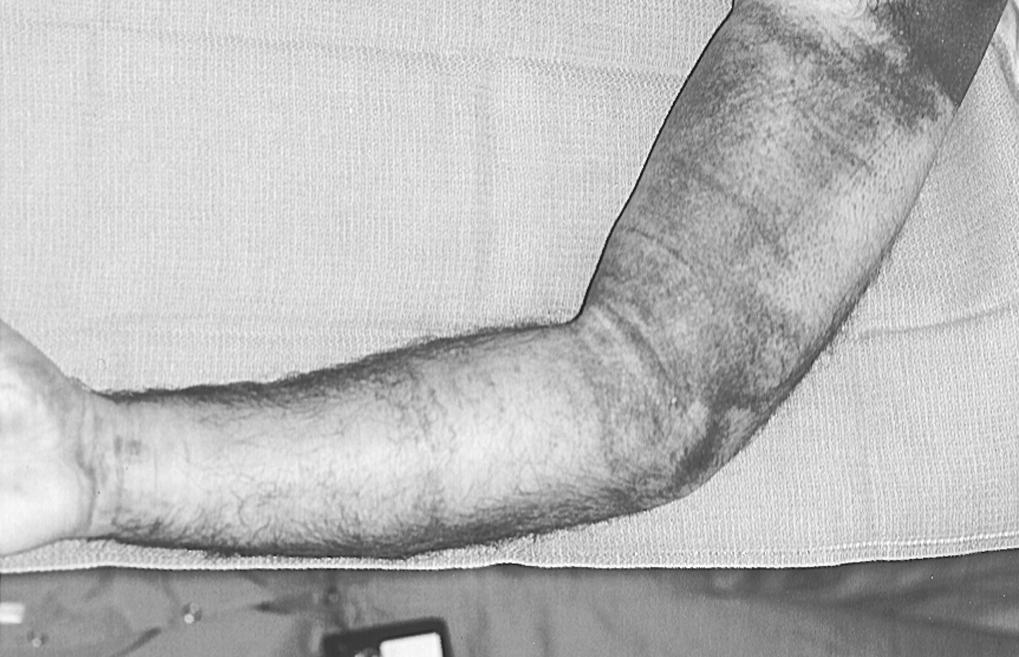
Patients should be asked about antecedent symptoms, which usually are not present but may indicate chronic bursitis or tendonitis. Additionally, patients should be questioned about smoking, systemic disease, steroids, and prior history of fluoroquinolone usage.
Inspection of the involved extremity may identify bruising and/or proximal retraction of the biceps muscle belly. In patients in whom the lacertus fibrosus is intact, the proximal retraction of the biceps muscle can appear minimal. For all examination maneuvers, the symptomatic side should be compared to the asymptomatic side.
On palpation of a complete rupture, the tense cordlike distal biceps tendon is absent from the antecubital fossa. However, an intact lacertus fibrosus can mimic the biceps tendon. The intact lacertus fibrosus is usually more medially situated in the antecubital fossa and feels thinner, with a sharper leading edge, whereas the intact biceps tendon feels more tubular and can usually be encircled or hooked by the examiner's finger. Typically, palpation tenderness is minimal but may be present in the antecubital fossa and over the proximally retracted muscle belly. Range of motion of the injured elbow is usually normal but can be limited by pain.
Strength examination of the injured arm usually demonstrates weakness with flexion and supination. Additionally, patients may also have weakness with ipsilateral grip strength.
Several special tests have been described for the diagnosis of a complete distal biceps tendon avulsion. The biceps squeeze test is analogous to the Thompson test for the diagnosis of Achilles tendon ruptures. The test is conducted with the patient seated, arm flexed and slightly pronated, resting in the lap. The examiner then uses two hands to squeeze the biceps muscle belly firmly. A positive test occurs when the forearm does not supinate after the squeeze maneuver, indicating a disruption between the muscle belly and radius. The test has been reported to have a sensitivity of 96%. In this author's opinion, this particular test can be difficult to perform reliably as the biceps muscle belly is usually quite tender and painful after an acute rupture.
With disruption of the flexor mechanism, the biceps muscle belly loses its normal rise and fall with passive forearm supination and pronation, respectively ( Fig. 63.4 ). The passive pronation test is used to determine this discontinuity in the biceps mechanism. A negative test, indicating an intact biceps, results in proximal to distal movement of the biceps muscle as the forearm is passively pronated from the fully supinated position. A positive test occurs when the biceps muscle does not move distally with passive forearm rotation to full pronation. This test is reported to have 100% sensitivity and specificity.
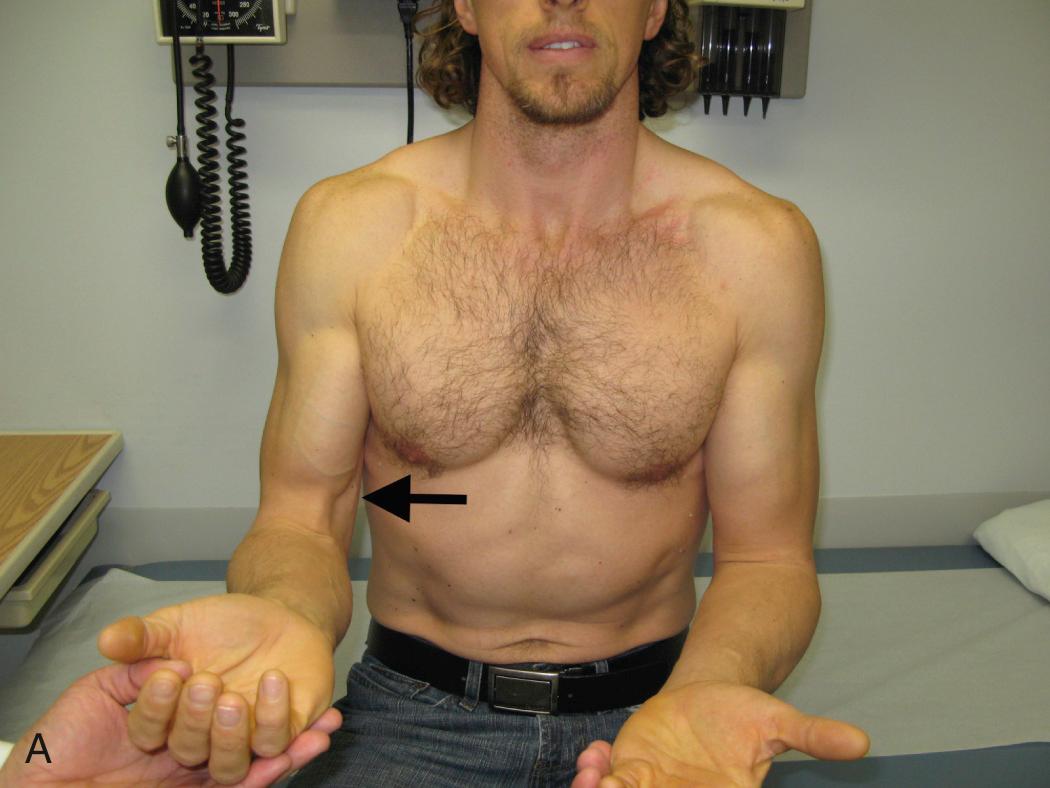
The hook test is based on palpation of the intact distal biceps tendon in the antecubital fossa. The test is performed with the patient actively abducting the shoulder to 90 degrees, with the elbow flexed to 90 degrees and the forearm in full supination. The examiner uses his or her index finger to hook the distal biceps tendon from lateral to medial across the antecubital fossa ( Fig. 63.5 ). The maneuver is conducted laterally to medially to avoid mistaking the intact lacertus as the biceps tendon. It is conducted bilaterally, and an ability to hook the distal biceps tendon demonstrates that it is intact. In this circumstance, the test is referred to as normal. An inability to hook the tendon demonstrates that it is disrupted, and the test is then referred to as abnormal. This test has a reported sensitivity, specificity, positive predictive value, and negative predictive value of 100%.
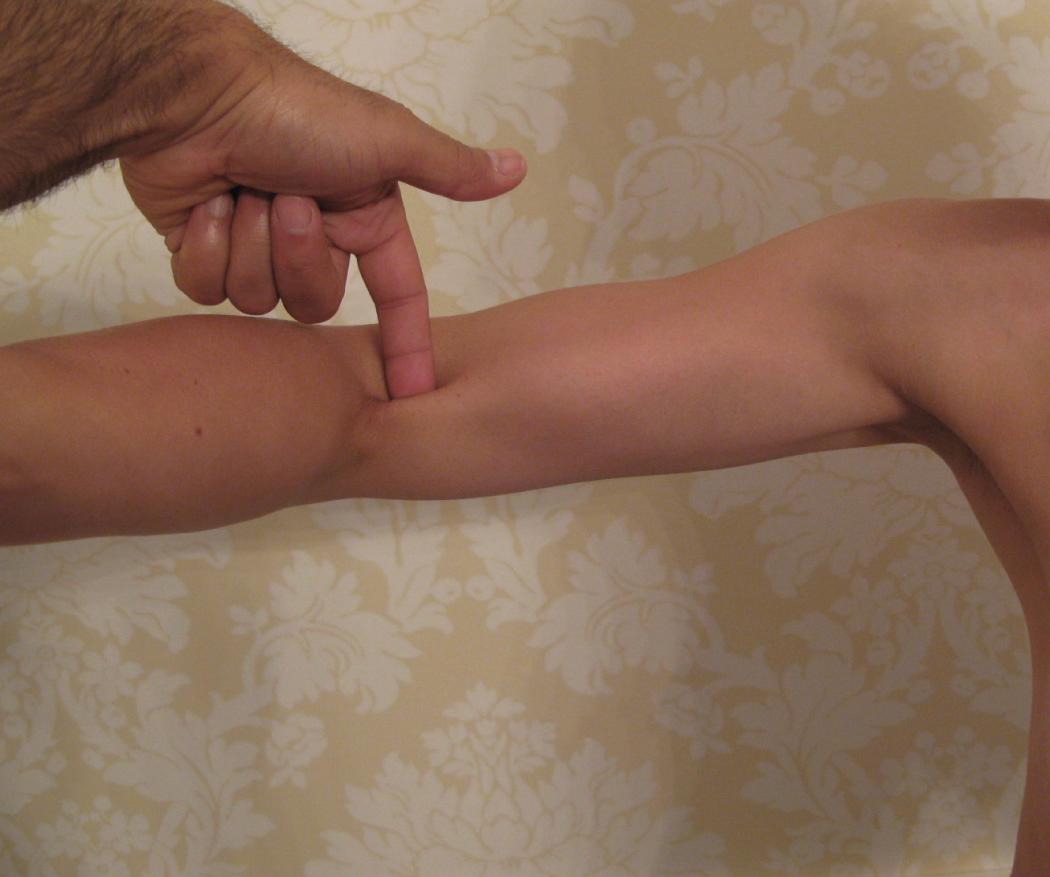
The biceps crease interval is a measurement technique to identify proximal retraction of the biceps muscle, which is usually indicative of a complete distal tendon avulsion. The measurement is conducted by first marking the antecubital flexion crease. Then the cusp of the distal descent of the biceps muscle is marked. The cusp is determined by assessing the contour of the distal biceps muscle and identifying the point at which the curve of the muscle begins to turn most sharply toward the antecubital fossa. A biceps crease interval of greater than 6 cm usually indicates a complete rupture. Additionally, the authors of this study demonstrated that the side-to-side difference in the biceps crease interval measurement is minimal. Therefore, if the ratio of the injured to noninjured biceps crease interval measurement is greater than 1.2, it usually indicates a complete tear. This side-to-side comparison of the biceps crease interval is referred to as the biceps crease ratio .
Although several tests for the diagnosis of complete distal biceps tendon ruptures have demonstrated a high degree of sensitivity and specificity, Devereaux and ElMaraghy have developed a battery of three tests with a reported 100% sensitivity and specificity. They combined three tests—the hook test, passive forearm pronation test, and biceps crease interval test. When all three test results are in agreement, the sensitivity and specificity are reported to be 100%.
All patients with presumed distal biceps tendon injuries should undergo standard elbow radiography. Radiographs are useful in ruling out associated injuries. Additionally, radiographs may demonstrate flakes of avulsed bone or hypertrophic enthesophytes ( Fig. 63.6 ). Typically, the diagnosis of a complete distal biceps tendon acute rupture can be made clinically. However, if the diagnosis is in question, soft tissue imaging with ultrasound or magnetic resonance imaging (MRI) may be effective. Ultrasonography is user-dependent, but it can effectively image the detached distal biceps tendon. Additionally, ultrasonography of the posterolateral forearm with the arm in hyperpronation may identify the bare bicipital tuberosity.
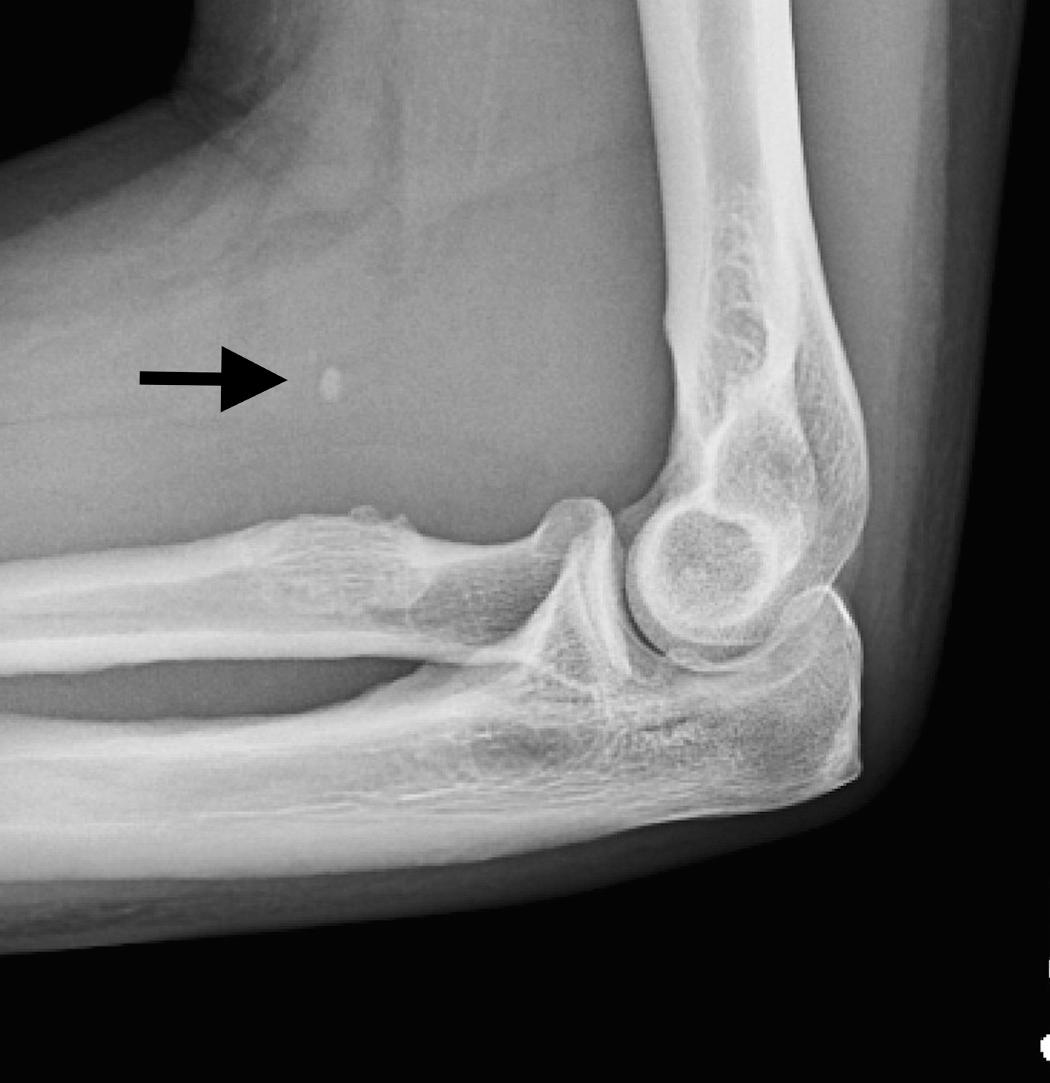
MRI is also effective in imaging the distal biceps tendon and bicipital tuberosity. Standard MRI views are usually effective; however, Giuffre and Moss have identified a biceps-specific view, termed the flexion, abduction, supination view . This MRI view allows better visualization of the entire distal biceps tendon from the musculotendinous junction to the insertion on the tuberosity. To obtain this view, the patient is positioned in the MRI scanner lying prone, with the arm in abduction over the head, the elbow in flexion, and the forearm in supination ( Fig. 63.7 ).
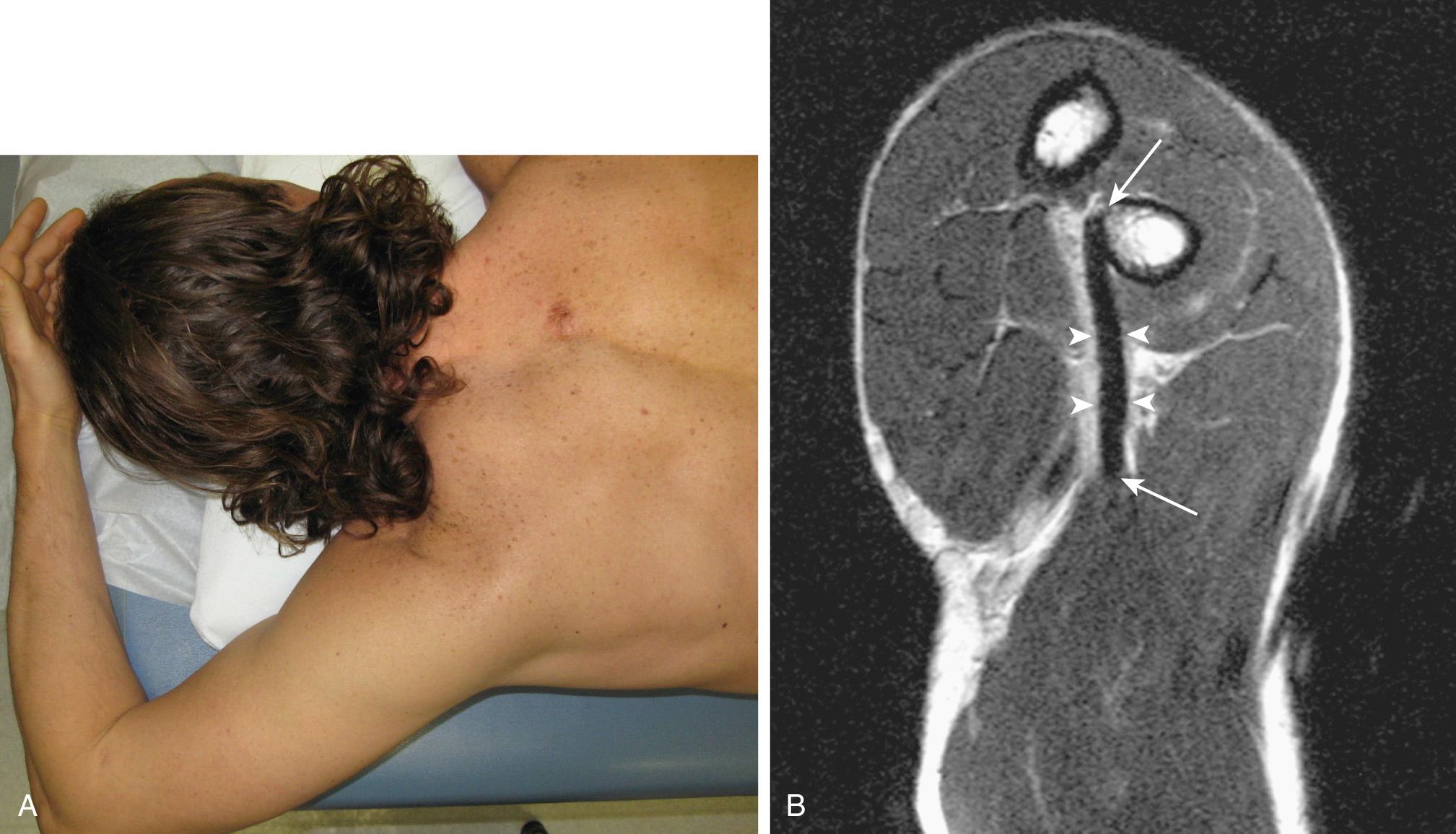
Become a Clinical Tree membership for Full access and enjoy Unlimited articles
If you are a member. Log in here